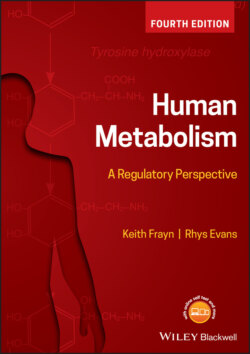Читать книгу Human Metabolism - Keith N. Frayn - Страница 21
1.2.2.2 Fats
ОглавлениеJust as there are many different sugars and carbohydrates built from them, so there are a variety of types of fat. The term fat comes from Anglo-Saxon and is related to the filling of a container or vat. The term lipid, from Greek, is more useful in chemical discussions since ‘fat’ can have so many shades of meaning. Lipid materials are those substances which can be extracted from tissues in organic solvents such as petroleum or chloroform. This immediately distinguishes them from the largely water-soluble carbohydrates.
Among lipids there are a number of groups (Figure 1.4). The most prevalent, in terms of amount, are the triacylglycerols or triglycerides, referred to in older literature as ‘neutral fat’ since they have no acidic or basic properties. These compounds consist of three individual fatty acids, each linked by an ester bond to a molecule of glycerol. As discussed above, the triacylglycerols are very non-polar, hydrophobic compounds. The phospholipids are another important group of lipids – constituents of membranes and also of the lipoprotein particles which will be discussed in Chapter 10. Steroids – compounds with the same nucleus as cholesterol (Figure 1.6) – form yet another important group and will be considered in later chapters, steroid hormones in Chapter 6 and cholesterol metabolism in Chapter 10.
Fatty acids are the building blocks of lipids, analogous to the monosaccharides. The fatty acids important in metabolism are mostly unbranched, long-chain (12 carbon atoms or more) carboxylic acids with an even number of carbon atoms. They may contain no double bonds, in which case they are referred to as saturated fatty acids, one double bond (mono-unsaturated fatty acids), or several double bonds – the polyunsaturated fatty acids. Many individual fatty acids are named, like monosaccharides, according to the source from which they were first isolated. Thus, lauric acid (C12, saturated) comes from the laurel tree, myristic acid (C14, saturated) from the Myristica or nutmeg genus, palmitic acid (C16, saturated) from palm oil, and stearic acid (C18, saturated) from suet, or hard fat (Greek στέαρ [steatos]). Oleic acid (C18, mono-unsaturated) comes from the olive (from Latin: olea, olive, or oleum, oil). Linoleic acid (C18 with two double bonds) is a polyunsaturated acid common in certain vegetable oils; it is obtained from linseed (from the Latin linum for flax and oleum for oil).
The fatty acids mostly found in the diet have some common characteristics. They are composed of even numbers of carbon atoms, and the most abundant have 16 or 18 carbon atoms. There are three major series or families of fatty acids, grouped according to the distribution of their double bonds (Box 1.3).
